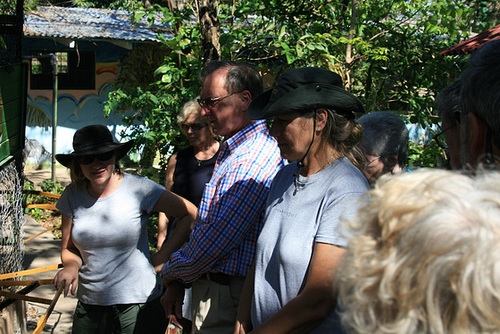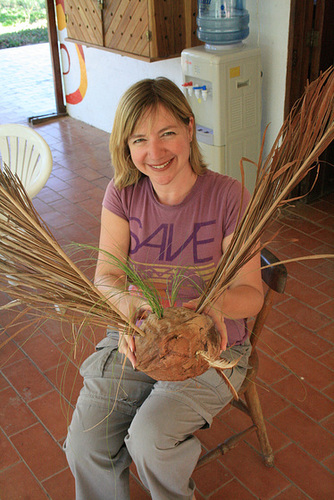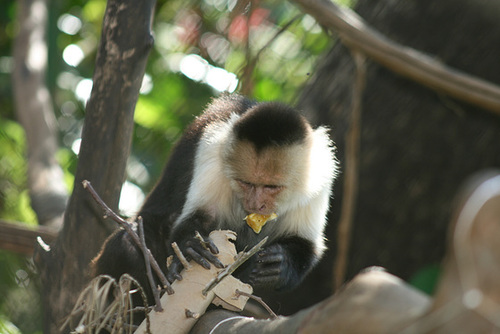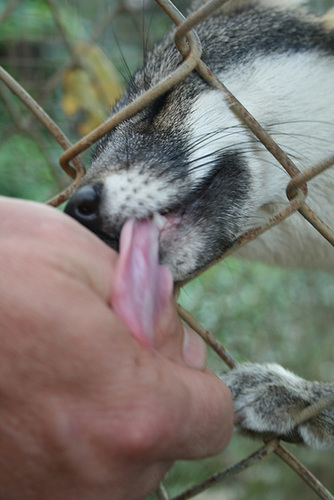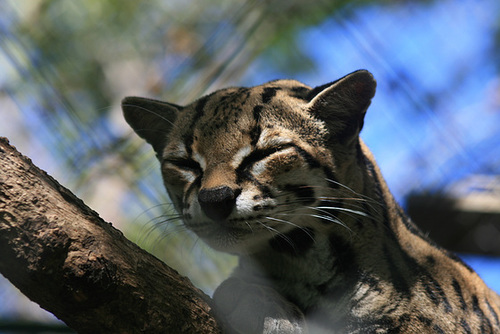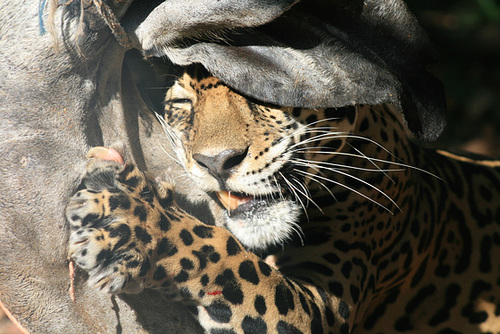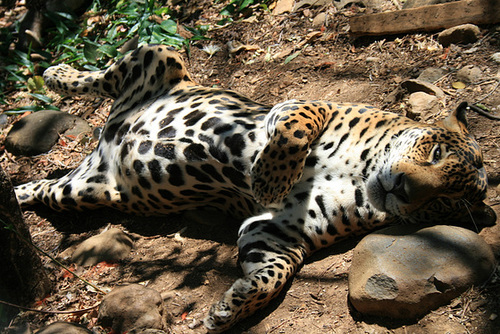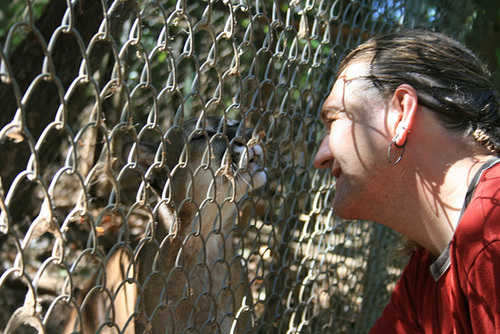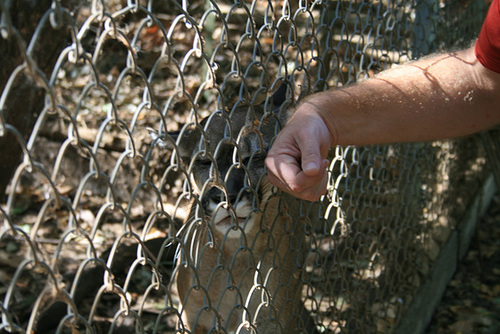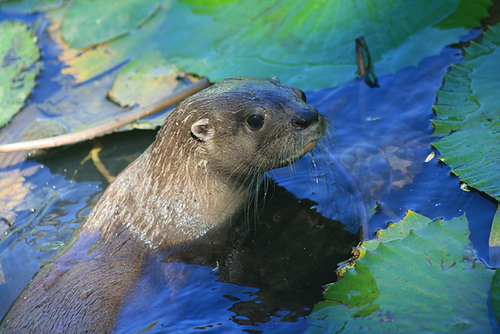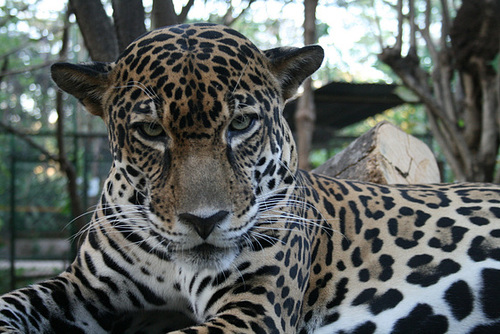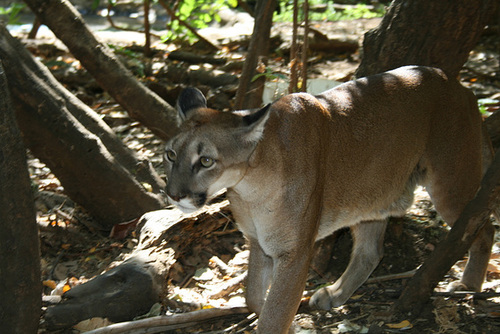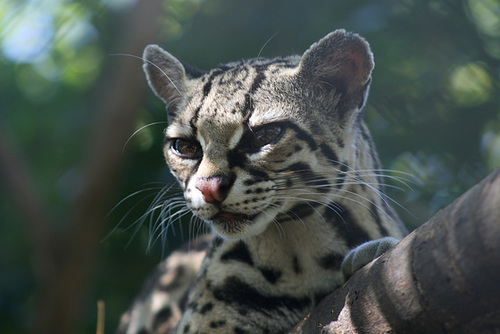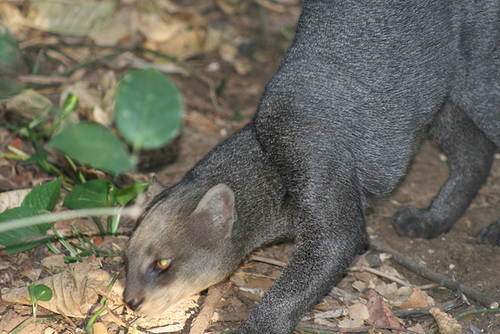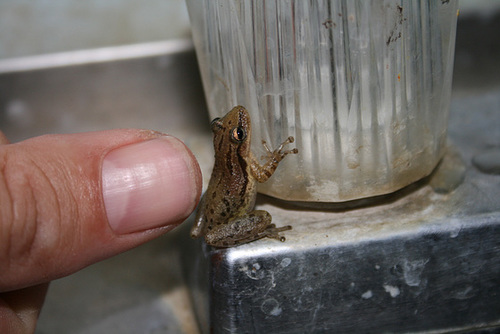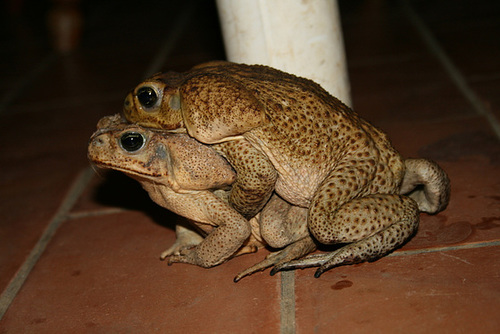? to 30 Mar, 2009 - Cañas (Las Pumas) and trips around, Costa Rica
This is sort of a continuation of the previous entry, so I strongly recommend that if you are reading this blog top down, you skip ahead and read the entry below before reading here.
We are almost finished here at Las Pumas Rescue Centre, and we are not looking forward to having to say goodbye. We have become particularly attached to the animals.

Two Pumas Come To Visit Jo In Her Cage
Pumas pay a lot of money to come and see a Jo. This Jo doesn't know how to look after herself in the wild and can not be re-released.

Jo Really Hits The Right Spot
Dalila expresses great delight at the attention she receives from Jo.
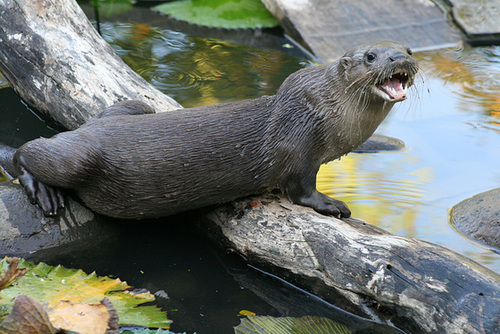
Frankie Chatters
Frankie the otter chatters from the other side of his pool.

Proud Of His Work
One of the visitors who came with his class to do some animal education. Education is one of the very important functions of the animal rescue centre.
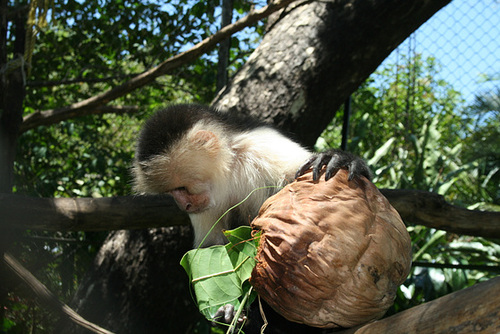
Opening A Present
A monkey opens a coconut with various presents stuffed inside that she needs to sort through to get to the fruit.
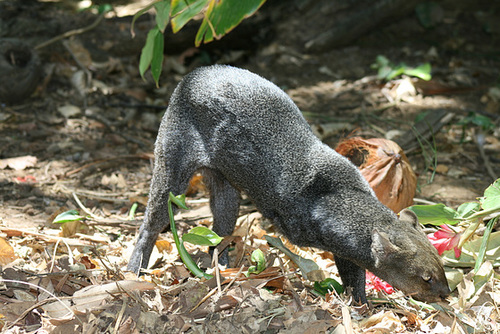
Tres Patas
Tres Patas means Three Feet. This is a jaguarondi who needed to have a leg amputated. She still does very well, but would obviously struggle to survive in the wild.

Sansón Agrees To Give An Interview
Actually, the truth is just as strange. We were roaming with wireless internet, trying to get some animals to purr or make some audible noise, for our nephew, Ben, who was listening from Australia.
Jo has been the victim of two cat attacks during our stay. The first was a small scratch when Rosita the ocelot reached out of her enclosure quite suddenly, striking out inquisitively at a movement from the corner of her eye. Unfortunately that movement was Jo's shorts! The second has caused a bit of tension. Rafa, one of the jaguars, came up to us at the fence, turned suddenly, and then sprayed Jo's legs with a fine mist. I don't really know if he was laying claim to her! I mean, I hope not, as seriously, I feel obliged to fight for her, but I don't like my chances.
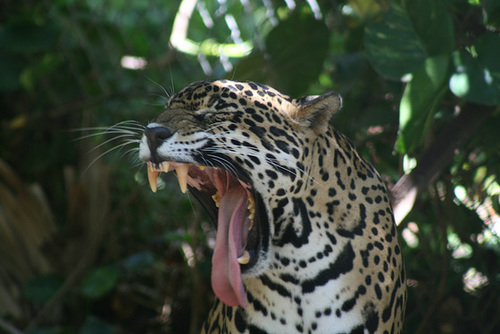
Are We Keeping You Up?
Rafa yawns like he means it!
And the incidental animal encounters have continued. The toads continue to bonk incessantly all night, iguanas still hang out of the ceiling, and frogs keep appearing in and on all manner of things. In the last week we have also encountered a relatively attractive, but “keep your distance”, scorpion. On top of this, there have been snakes in and around the mice breeding enclosures. A couple of boas, too large to get in, did their window shopping around the outside, perhaps finding a stray on the floor or in the hay. One night, a false coral snake found the tiniest of holes – we discovered it lying in the middle of four or five half mice, partly consumed and then abandoned. There were also a half dozen pinkies lying around it, and it was just throwing his head back, swallowing one after another. If it had been a person, it probably would have belched at this point, excused itself, and continued tossing baby mice down its throat!
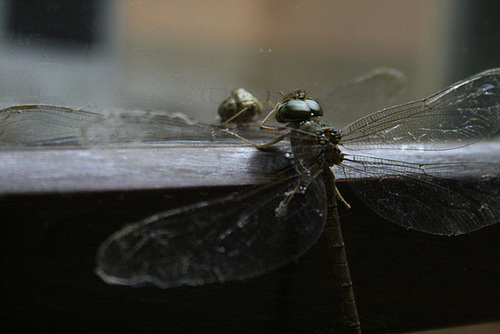
A Narcissistic Dragonfly
A dragonfly in our bathroom is caught out checking her hair and makeup.
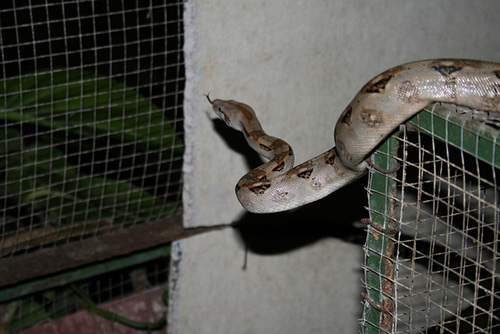
Clearing Out
A boa makes his exit after being disturbed window shopping at the mice cages.
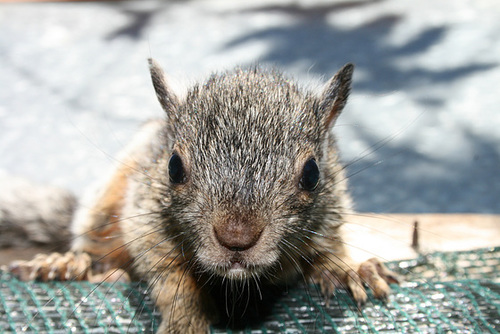
Does My Face Look Big In This?
An inquisitive squirrel checks out the photographer.

Scorpion
One of the visitors to our verandah that we have to be a bit more careful about.
One night, we were doing our usual rounds, saying goodnight to the animals. Surprisingly, we could not find Julieta (a puma), who almost always comes for a couple of minutes at least. We were just about to give up and head off when a head popped out from a high platform, right next to where we were standing. It was so cute, in the near pitch black, with this puma face hanging down - “Here I am. I was hiding. It was a good spot, hey! Goodnight.”
We have managed a few trips on our “days off”.
We made a trip in to town, Cañas, on the first weekend here. It was the weekend of their annual “tope”. The “tope” itself is a giant horse parade, where men and their equines show their skills. But it is in reality also an excuse for a week or two of partying. Rides, games, fireworks, food, and plenty of drink. The running of the bulls, and the bull riding are held at this time, too. During the week, the bull riding is an amateur class, but on the Saturday night, the serious competitions kicked off, and my goodness, their were some big bulls, and some are notorious, with bulls gaining reputations on the circuit as much as any rider might. The most intriguing part of watching the bull riding, at Plaza del Toros, was the local macho youths who climb in. They are not needed in there, but they are not restricted. Some are inebriated, but most are not particularly far along that path. They are in there for the thrill of staying out of the way of the bull. After it throws its rider, they try and catch its attention, running off at right angles should it charge towards them. Between riders coming out, they stand around chatting, drinking, or talking on their mobile phones. Some continue to do this while the bull is in the ring! If near the edge of the ring, they may choose to climb the wall quickly. During one ride, a man's face popped up over the railing, directly in front of us, and he was still talking on the phone! No need for rodeo clowns, here. The clowns volunteer.

Make Way For The Bull
As the bull circles, looking for the exit, young men (many inebriated) in the bull ring act as pseudo rodeo clowns. They expect no payment other than the thrill of avoiding a rampant bull. In fact, they have paid an entry fee, so are out of pocket for the privilege.

Competition Bull Riding
One of the professional competitors shows what he is capable of. Onlookers watch from close quarters, ready to scatter should the bull turn their way.
Parque Nacional Volcán Tenorio is on the slopes of the volcano, Tenorio. There is thermal activity in a number of spots, but the main reason to visit is to see the mineral laden waters, which flow down a milky stream, through a series of pools, and eventually over a waterfall into a turquoise catchment.

A Mineral Filled Waterfall
Milky blue water cascades into a pool, at Parque Nacional Volcán Tenorio.
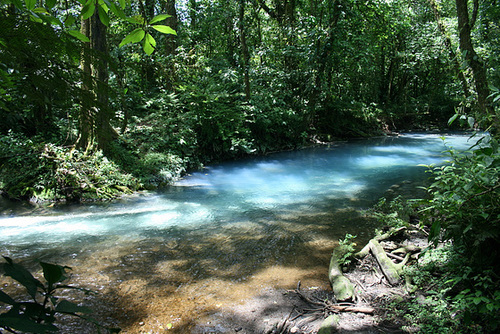
Confluence Of Clear And Milky
A mineral filled milky stream of water and a clear stream come together in a striking way.
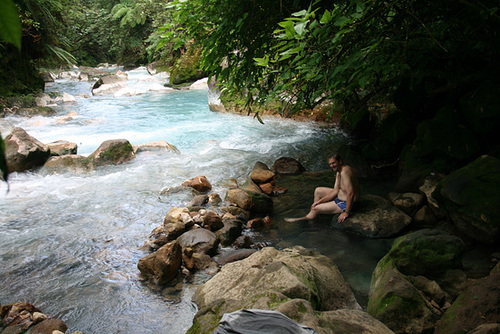
A Hot Spring By A River
Some cold water gets diverted from the stream into the makeshift hot tub, creating a strange bathing experience. Waves of hot and cold water, which haven't mixed very well at all, keep you on edge. However, when you find the right spot, it is a most enjoyable experience.
Another centre of thermal activity, Parque Nacional Rincón De La Vieja, was full of steaming vents, bubbling pools of mud, and steaming rivers of near boiling water. It even has a giant vent, called “Volcancito”, or little volcano. Not quite lava, but the mud and steam spewing out its mouth were awe inspiring.
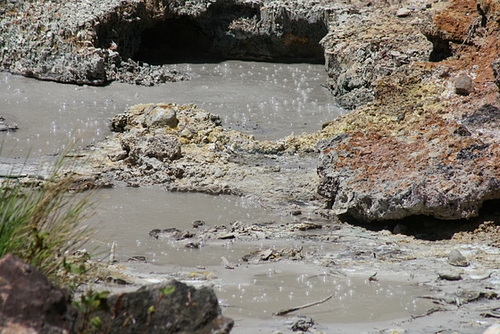
Thermal Activity
Bubbling springs at Rincón De La Vieja.

Mud Bubble
A bubble of mud explodes.
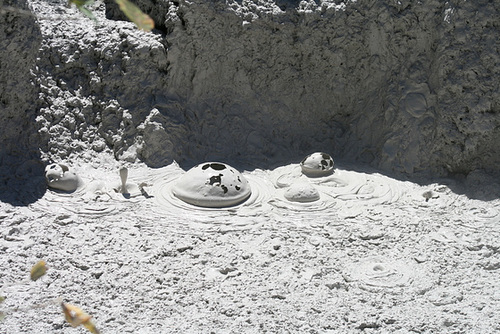
A Row Of Mud Bubbles
A pool of very hot mud.
Nearby is Parque Nacional Palo Verde. Temperatures in the high 30's and low 40's, and no rain, mean that its sizable lake is currently comparatively tiny. From the shores, we walked maybe nearly a km over dry and cracked mud till we reached the water's edge. Here, countless birds of many different species co-mingled in the remaining swampy puddle. When the rain comes, in the next month or two, the puddle will explode in to a sizable body of water again. Hard to imagine, when everything is so parched, but from a viewpoint we climbed to, the regular lake shoreline could be clearly discerned.
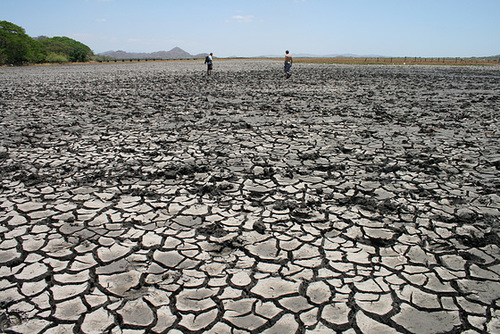
Richard And David Strike Out Across The Dry Mud
The lake in Parque Nacional Palo Verde is almost entirely gone, as it is getting towards the end of the dry season. To see the birds, we had to walk out quite a distance.
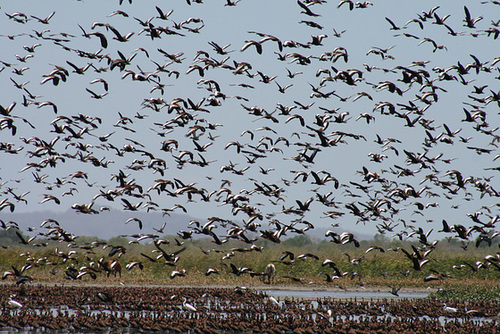
Water Birds Concentrated When There Is Not Much Water
The last remaining water in the lake in Parque Nacional Palo Verde. There must be at least a dozen species represented here – we were able to identify nine or ten. The numbers of birds was phenomenal, and I wouldn't even want to hazard a guess.

Jo Enjoys The Spectacle
After walking quite a distance in the heat in the open sun, across the dried mud flats, we got to enjoy the birds from the shore of what remained of the lake.
This is sort of a continuation of the previous entry, so I strongly recommend that if you are reading this blog top down, you skip ahead and read the entry below before reading here.
We are almost finished here at Las Pumas Rescue Centre, and we are not looking forward to having to say goodbye. We have become particularly attached to the animals.

Two Pumas Come To Visit Jo In Her Cage
Pumas pay a lot of money to come and see a Jo. This Jo doesn't know how to look after herself in the wild and can not be re-released.

Jo Really Hits The Right Spot
Dalila expresses great delight at the attention she receives from Jo.

Frankie Chatters
Frankie the otter chatters from the other side of his pool.

Proud Of His Work
One of the visitors who came with his class to do some animal education. Education is one of the very important functions of the animal rescue centre.

Opening A Present
A monkey opens a coconut with various presents stuffed inside that she needs to sort through to get to the fruit.

Tres Patas
Tres Patas means Three Feet. This is a jaguarondi who needed to have a leg amputated. She still does very well, but would obviously struggle to survive in the wild.

Sansón Agrees To Give An Interview
Actually, the truth is just as strange. We were roaming with wireless internet, trying to get some animals to purr or make some audible noise, for our nephew, Ben, who was listening from Australia.
Jo has been the victim of two cat attacks during our stay. The first was a small scratch when Rosita the ocelot reached out of her enclosure quite suddenly, striking out inquisitively at a movement from the corner of her eye. Unfortunately that movement was Jo's shorts! The second has caused a bit of tension. Rafa, one of the jaguars, came up to us at the fence, turned suddenly, and then sprayed Jo's legs with a fine mist. I don't really know if he was laying claim to her! I mean, I hope not, as seriously, I feel obliged to fight for her, but I don't like my chances.

Are We Keeping You Up?
Rafa yawns like he means it!
And the incidental animal encounters have continued. The toads continue to bonk incessantly all night, iguanas still hang out of the ceiling, and frogs keep appearing in and on all manner of things. In the last week we have also encountered a relatively attractive, but “keep your distance”, scorpion. On top of this, there have been snakes in and around the mice breeding enclosures. A couple of boas, too large to get in, did their window shopping around the outside, perhaps finding a stray on the floor or in the hay. One night, a false coral snake found the tiniest of holes – we discovered it lying in the middle of four or five half mice, partly consumed and then abandoned. There were also a half dozen pinkies lying around it, and it was just throwing his head back, swallowing one after another. If it had been a person, it probably would have belched at this point, excused itself, and continued tossing baby mice down its throat!

A Narcissistic Dragonfly
A dragonfly in our bathroom is caught out checking her hair and makeup.

Clearing Out
A boa makes his exit after being disturbed window shopping at the mice cages.

Does My Face Look Big In This?
An inquisitive squirrel checks out the photographer.

Scorpion
One of the visitors to our verandah that we have to be a bit more careful about.
One night, we were doing our usual rounds, saying goodnight to the animals. Surprisingly, we could not find Julieta (a puma), who almost always comes for a couple of minutes at least. We were just about to give up and head off when a head popped out from a high platform, right next to where we were standing. It was so cute, in the near pitch black, with this puma face hanging down - “Here I am. I was hiding. It was a good spot, hey! Goodnight.”
We have managed a few trips on our “days off”.
We made a trip in to town, Cañas, on the first weekend here. It was the weekend of their annual “tope”. The “tope” itself is a giant horse parade, where men and their equines show their skills. But it is in reality also an excuse for a week or two of partying. Rides, games, fireworks, food, and plenty of drink. The running of the bulls, and the bull riding are held at this time, too. During the week, the bull riding is an amateur class, but on the Saturday night, the serious competitions kicked off, and my goodness, their were some big bulls, and some are notorious, with bulls gaining reputations on the circuit as much as any rider might. The most intriguing part of watching the bull riding, at Plaza del Toros, was the local macho youths who climb in. They are not needed in there, but they are not restricted. Some are inebriated, but most are not particularly far along that path. They are in there for the thrill of staying out of the way of the bull. After it throws its rider, they try and catch its attention, running off at right angles should it charge towards them. Between riders coming out, they stand around chatting, drinking, or talking on their mobile phones. Some continue to do this while the bull is in the ring! If near the edge of the ring, they may choose to climb the wall quickly. During one ride, a man's face popped up over the railing, directly in front of us, and he was still talking on the phone! No need for rodeo clowns, here. The clowns volunteer.

Make Way For The Bull
As the bull circles, looking for the exit, young men (many inebriated) in the bull ring act as pseudo rodeo clowns. They expect no payment other than the thrill of avoiding a rampant bull. In fact, they have paid an entry fee, so are out of pocket for the privilege.

Competition Bull Riding
One of the professional competitors shows what he is capable of. Onlookers watch from close quarters, ready to scatter should the bull turn their way.
Parque Nacional Volcán Tenorio is on the slopes of the volcano, Tenorio. There is thermal activity in a number of spots, but the main reason to visit is to see the mineral laden waters, which flow down a milky stream, through a series of pools, and eventually over a waterfall into a turquoise catchment.

A Mineral Filled Waterfall
Milky blue water cascades into a pool, at Parque Nacional Volcán Tenorio.

Confluence Of Clear And Milky
A mineral filled milky stream of water and a clear stream come together in a striking way.

A Hot Spring By A River
Some cold water gets diverted from the stream into the makeshift hot tub, creating a strange bathing experience. Waves of hot and cold water, which haven't mixed very well at all, keep you on edge. However, when you find the right spot, it is a most enjoyable experience.
Another centre of thermal activity, Parque Nacional Rincón De La Vieja, was full of steaming vents, bubbling pools of mud, and steaming rivers of near boiling water. It even has a giant vent, called “Volcancito”, or little volcano. Not quite lava, but the mud and steam spewing out its mouth were awe inspiring.

Thermal Activity
Bubbling springs at Rincón De La Vieja.

Mud Bubble
A bubble of mud explodes.

A Row Of Mud Bubbles
A pool of very hot mud.
Nearby is Parque Nacional Palo Verde. Temperatures in the high 30's and low 40's, and no rain, mean that its sizable lake is currently comparatively tiny. From the shores, we walked maybe nearly a km over dry and cracked mud till we reached the water's edge. Here, countless birds of many different species co-mingled in the remaining swampy puddle. When the rain comes, in the next month or two, the puddle will explode in to a sizable body of water again. Hard to imagine, when everything is so parched, but from a viewpoint we climbed to, the regular lake shoreline could be clearly discerned.

Richard And David Strike Out Across The Dry Mud
The lake in Parque Nacional Palo Verde is almost entirely gone, as it is getting towards the end of the dry season. To see the birds, we had to walk out quite a distance.

Water Birds Concentrated When There Is Not Much Water
The last remaining water in the lake in Parque Nacional Palo Verde. There must be at least a dozen species represented here – we were able to identify nine or ten. The numbers of birds was phenomenal, and I wouldn't even want to hazard a guess.

Jo Enjoys The Spectacle
After walking quite a distance in the heat in the open sun, across the dried mud flats, we got to enjoy the birds from the shore of what remained of the lake.
